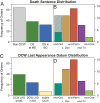Dead clades walking are a pervasive macroevolutionary pattern
- PMID: 33827921
- PMCID: PMC8053996
- DOI: 10.1073/pnas.2019208118
Dead clades walking are a pervasive macroevolutionary pattern
Abstract
D. Jablonski [Proc. Natl. Acad. Sci. U.S.A. 99, 8139-8144 (2002)] coined the term "dead clades walking" (DCWs) to describe marine fossil orders that experience significant drops in genus richness during mass extinction events and never rediversify to previous levels. This phenomenon is generally interpreted as further evidence that the macroevolutionary consequences of mass extinctions can continue well past the formal boundary. It is unclear, however, exactly how long DCWs are expected to persist after extinction events and to what degree they impact broader trends in Phanerozoic biodiversity. Here we analyze the fossil occurrences of 134 skeletonized marine invertebrate orders in the Paleobiology Database (paleobiodb.org) using a Bayesian method to identify significant change points in genus richness. Our analysis identifies 70 orders that experience major diversity losses without recovery. Most of these taxa, however, do not fit the popular conception of DCWs as clades that narrowly survive a mass extinction event and linger for only a few stages before succumbing to extinction. The median postdrop duration of these DCW orders is long (>30 Myr), suggesting that previous studies may have underestimated the long-term taxonomic impact of mass extinction events. More importantly, many drops in diversity without recovery are not associated with mass extinction events and occur during background extinction stages. The prevalence of DCW orders throughout both mass and background extinction intervals and across phyla (>50% of all marine invertebrate orders) suggests that the DCW pattern is a major component of macroevolutionary turnover.
Keywords: biodiversity; macroevolution; mass extinction; recovery.
Conflict of interest statement
The authors declare no competing interest.
Figures




References
-
- Raup D. M., Sepkoski J. J., Mass extinctions in the marine fossil record. Science 215, 1501–1503 (1982). - PubMed
-
- Jablonski D., Extinctions in the fossil record. Philos. Trans. R. Soc. Lond. B 344, 11–17 (1994).
-
- Bambach R. K., Phanerozoic biodiversity mass extinctions. Annu. Rev. Earth Planet Sci. 34, 127–155 (2006).
-
- Jablonski D., Background and mass extinctions: The alternation of macroevolutionary regimes. Science 231, 129–133 (1986). - PubMed
-
- Jablonski D., Evolutionary innovations in the fossil record: The intersection of ecology, development, and macroevolution. J. Exp. Zool. 304, 504–519 (2005). - PubMed
Publication types
MeSH terms
LinkOut - more resources
Full Text Sources
Other Literature Sources
Miscellaneous

